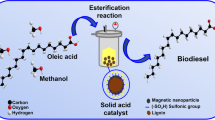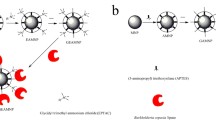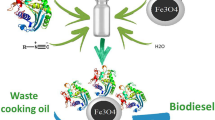Abstract
Fe3O4 nanoparticles were modified with tetraethylorthosilicate (TEOS) and (3-chloropropyl)trimethoxysilane (CPTMS) followed by immobilization with different amines such as guanine, piperazine, methylamine, morpholine, aniline, ethylenediamine, 3-aminopropyltriethoxysilane, and melamine, designated as Fe3O4@SiO2@CPTMS@amine (nanocatalyst). The prepared nanocatalysts were characterized by means of FTIR, XRD, VSM, SEM, and TEM. Trans-esterification reactions of soybean oil with methanol were then carried out in the presence of the Fe3O4@SiO2@CPTMS@amine as a nanocatalyst. Optimization of the reaction parameters revealed that the fatty acid methyl esters (FAMEs or biodiesel) is obtained in 6–96% yields by using methanol to oil molar ratio of 36 in the presence of 6% of nanocatalysts containing melamine and guanine, respectively, at 160 °C within 3 h. The stability and reusability of the catalyst as well as the effect of reaction parameters on the FAME yield are described in this paper.
Similar content being viewed by others
Explore related subjects
Discover the latest articles, news and stories from top researchers in related subjects.Avoid common mistakes on your manuscript.
Introduction
Magnetic nanoparticles with uniform size distribution are of interest because of their extensive applications in magnetically controlled drug delivery, memory storage devices, MRI, sensors, and catalysis [1,2,3,4]. In fact, the immobilization of the catalytically active species on the surface of modified magnetic nanoparticles is a suitable method because of the easy catalyst separation by applying an external magnetic field [5,6,7,8]. Recovery and reuse of catalysts after catalytic reactions are also important factors for sustainable process management. Directed functionalization of the surfaces of nanosized magnetic materials is an elegant way to bridge the gap between heterogeneous and homogeneous catalysis systems. Several organic reactions such as olefin epoxidation, decarboxylative coupling, and hydrogenation reactions have been carried out using catalysts immobilized on nanomagnetic particles as support [9,10,11,12,13,14]. In this study, attempt has been made on the modification of nanomagnetic particles with different amines for biodiesel production.
Biodiesel is a mixture of fatty acid methyl esters (FAMEs), produced by trans-esterification of triglycerides with methanol or other short-chain alcohols in the presence of an appropriate catalyst [15,16,17,18]. Due to the cost of fossil fuels to energy crisis as well as environmental pollutions, global warming, and greenhouse gas emission, an alternative and renewable source of energy has become more attractive in recent years. Not only biodiesel is a biodegradable fuel, non-toxic, and free of sulfur and carcinogenic compounds, it is also is a cleaner burning fuel than petrol and diesel. Trans-esterification reactions for production of biodiesel are commonly catalyzed by acids or bases in homogeneous or heterogeneous systems [19]. It was found that the biodiesel production in basic media is more common than acidic [20,21,22,23]. Heterogeneous catalysts with high catalytic performance in the synthesis of biodiesel are also environmentally friendly and are removable and reusable [24]. Nowadays, a wide variety of heterogeneous catalysts including microporous [25,26,27], or mesoporous materials [28], heteropolyacids [29], coordination polymers [30], metal organic frameworks [31,32,33], and finally oxides or mixed oxides nanocomposites have been investigated as catalyst for production of biodiesel using trans-esterification reactions [34,35,36].
Experimental
Materials and physical measurements
All materials were of commercial reagent grade and used without further purification. Methanol, tetraethyl orthosilicate, sodium chloride, ferric chloride, ferrous chloride tetrahydrate, ammonia (25% in water), glycerol, acetic acid, ethanol, potassium chloride, (3-chloropropyl)trimethoxysilane, guanine, melamine, morpholine, ethylenediamine, methyl amine, aniline, piperazine, diethyl ether, sodium hydride, and 3-aminopropyltrimethoxysilane were obtained from Merck Chemical Company. Commercial edible soybean oil was obtained from local grocery store with the average molecular weight of 881 g/mol (calculated from the saponification value S.V. = 190 mg KOH/g, with acid value and water contents of 0.4 mg KOH/g and 96.7 mg/kg, respectively).
The X-ray diffractions (XRD) were recorded on a Siefert 3003 PTS diffractometer using Cu Kα radiation (k = 0.15406 nm). FTIR spectra were recorded by Bruker Tensor 27 FTIR spectrometer device in the range of 4000–400 cm−1 with KBr pellet (5 mg sample with 100 mg KBr). Vibrating sample magnetometer (VSM) using the (BHV-55, Riken, Japan) with magnetic fields in the range − 8000 to 8000 Oe was conducted at room temperature. To see the reaction efficiency, GC Agilent 6890 series equipped with a flame ionization Detector FID detector, HP-5, 5% phenylmethylsiloxane capillary was used. Biodiesel composite was determined by Agilent 5973 network, mass selective detector, HP-5 MS 6989 network GC system. The morphology and particle size of the prepared nanocomposites were determined by scanning electron microscopy (SEM) images with model KYKY-EM3200-26 kV. Transmission electron microscopy (TEM) images were taken by Zeiss-EM10C-100 kV.
Preparation of Fe3O4@SiO2@CPTMS
Silica-coated Fe3O4 magnetic nanoparticles (SCMNPs) were prepared according to the previously reported procedure [37] (see also supplementary materials). The silica-coated magnetic nanoparticles SCMNPs (2 g) were suspended in ethanol (100 mL), and then (3-chloropropyl)trimethoxysilane (CPTMS) (2 mL) was added under nitrogen atmosphere. The mixture was heated at reflux for 12 h. The resultant solid was magnetically separated, washed with methanol in order to remove the unreacted residue of silylation reagent [37, 38].
Preparation of Fe3O4@SiO2@CPTMS@ amines
To a suspension of Fe3O4@SiO2@CPTMS (2 g) in ethanol (100 mL) were added amine (2 mmol) and KOH (0.1 g) dissolved in H2O (10 mL). The mixture was heated at reflux under nitrogen atmosphere for 12 h. The resultant solid was then magnetically separated, washed with methanol in order to remove the unreacted residue of silylation reagent.
Trans-esterification of soybean oil, general procedure
Trans-esterification reactions with different amines immobilized on modified magnetic nanoparticles were carried out in an autoclave with a mechanical stirrer. The catalyst (0.06 g) was dispersed in MeOH (3.2 mL), followed by the addition of soybean oil (5 mL) with the average molecular weight of 881 g/mol to the reaction mixture. After stirring for 2 h at 160 °C, the reaction mixture was cooled to room temperature. The catalyst was then separated using a magnet and washed with n-hexane. After evaporation of the solvent under reduced pressure, the two layers containing methyl esters, soybean oil, mono- and diglycerides in the upper, and glycerol in the lower phases were separated by a decanter. The FAME content was then determined by GC and GC/Mass analysis [39].
Results and discussion
Fe3O4@SiO2@CPTMS@amines were prepared according to the procedure presented in Scheme 1.
Magnetic nanoparticles (MNPs) were initially prepared by precipitation of iron (II) and iron (III) ions in a basic solution. Subsequently, silica was coated on Fe3O4 to form Fe3O4@SiO2 core–shell particles using TEOS in acidic solution to prevent the aggregation and increase in the stability of Fe3O4 nanoparticles [37]. The modification of magnetic nanoparticles surface is generally carried out by functionalization with desired organic groups [38, 39]. Therefore, after the surface functionalization with CPTMS, different amines such as guanine, piperazine, methylamine, morpholine, aniline, ethylenediamine, 3-aminopropyltriethoxysilane, and melamine were immobilized and designated as Fe3O4@SiO2@CPTMS@amines (Scheme 1).
The FTIR spectra of Fe3O4@SiO2@CPTMS, guanine, and Fe3O4@SiO2@CPTMS@guanines are presented in Fig. 1a–c, respectively. As indicated in Fig. 1a, the bands appearing at 448 and 579 cm−1 are attributed to the Fe–O vibrations and the band displaying at 1090 cm−1 is due to Si–O vibration. Two obvious bands appearing at 2870 and 2920 cm−1 are associated with C–H stretching vibrations of CPTMS immobilized on nanomagnet consistent with the predicted structure of Fe3O4@SiO2@CPTMS (Fig. 1c) [40]. Appearance of two bands around 3422–3100 cm−1 is due to the NH stretching vibrations of guanidine (Fig. 1b). A strong peak displaying at 1700 cm−1 due to the C=O vibrations is observed for guanine spectra before and after immobilization (Fig. 1b, c) [40,41,42,43,44]. The FTIR spectra for other amines such as piperazine, methylamine, morpholine, aniline, ethylenediamine, 3-aminopropyltriethoxysilane, and melamine are included in supplementary (Fig. S1). Comparison of the amines vibrations before and after immobilization confirmed the presence of immobilized amines (see supplementary Fig. S1a–h).
The XRD patterns of the prepared Fe3O4, Fe3O4@SiO2, Fe3O4@SiO2@CPTMS, Fe3O4@SiO2@CPTMS@guanine before and after the reaction are shown in Fig. 2. The diffraction peaks with 2θ values at 22°, 35°, 42°, 54°, 57° observed for Fe3O4 nanoparticles are related to the 220, 311, 411, 422, and 522, respectively. These results are consistent with those of the standard JCPDS card No. 190629 for iron oxide. The similarity observed in the XRD patterns of Fe3O4@SiO2@CPTMS and Fe3O4@SiO2@CPTMS@guanine indicates no change after immobilization of the amines (Fig. 2c, d).
The nanomagnetic properties of the prepared catalyst containing a magnetite component were studied by a VSM at 300 °K. The magnetization curves of Fe3O4, Fe3O4@SiO2@CPTMS, Fe3O4@SiO2@CPTMS@guanine before and after using as catalyst are shown in Fig. 3a–d, respectively. It was found that the magnetization saturated with iron oxide which was determined as 61 emu/g reduced to 57 emu/g when it was coated with silica. This reduction is due to coated with the silica. Before and after reaction, the magnetization is reduced to 42 and then 32 emu/g, which indicates that the catalyst has still superparamagnetic character.
The SEM and TEM images of Fe3O4@SiO2@CPTMS@guanine are shown in Fig. 4a, b, respectively. The SEM image shows the formation particles sizes between 45 and 65 nm (Fig. 4a). The formation of core and shell particles is evident in TEM image (Fig. 4b).
Investigation of the FTIR spectra of piperazine, methylamine, morpholine, aniline, ethylenediamine, 3-aminopropyltriethoxysilane, and melamine designated as Fe3O4@SiO2@CPTMS@amines (Scheme 1) (shown in supplementary, Fig. S1) indicates that the immobilization of these amines has been carried out succesfully. Moreover, modification of the iron oxide nanoparticles is confirmed on the basis of a decrease in the chlorine amount and the presence of nitrogen after immobilization of the desired organic amines based on the EDX results presented in Fig. 5 and Figs. S2–S7. Recall that the amount of nitrogen and chlorine depends on the amine type as indicated in supplementary (Figs. S2–S7).
Optimization of trans-esterification reaction parameters
In order to optimize the biodiesel yield, the effect of the amount of catalyst (based on the soybean oil weight), reaction time, methanol to oil molar ratio, and reaction temperature was investigated. As indicated in Fig. 6, there is a direct relation between the oil conversion and the amount of catalyst when the reaction is heated at reflux for 6 h. Significantly, trans-esterification reaction proceeded with 96% oil conversion together with the maximum formation of biodiesel in the presence of 6% catalyst.
Reaction temperature is also effective on the reaction rate as well as the biodiesel yield because the rate constant intrinsically depends on temperature. Notably, an increase in oil conversion from 16 to 96% was observed within 3 h when reaction temperature was marginally increased from 80 to 160 °C (Fig. 7).
It was also found that increasing the reaction time from 30 min to 3 h increased the reaction conversion from 34 to 96% (Fig. 8).
The effect of methanol to oil molar ratio shown in Fig. 9 reveals that increasing the molar ratio from 6:1 to 36:1 enhances the oil conversion from 6 to 96%. Therefore, the stoichiometry of trans-esterification reaction requires 3 mol of methanol per 1 mol of biodiesel and glycerol. Utilization of an excess amount of methanol seems to shift the equilibrium toward the product. Moreover, the excess of methanol accelerates the removal of the biodiesel product from the catalyst surface in order to regenerate the active sites.
The catalytic effect of immobilized amines of guanidine, piperazine, methylamine, morpholine, aniline, ethylenediamine, 3-aminopropyltriethoxysilane, and melamine on modified magnetic nanoparticles on the biodiesel production is given in Table 1. As seen in this table, the yield of reaction depends on the amine basicity (Table 1) since catalysts containing the most and least basic amines of guanine and melamine afforded the highest and lowest yields of biodiesel, respectively.
On the other hand, based on EDX results, no potassium ions were detected on the nanocomposite. The other point is the chlorine percent decreased after each immobilization. In which for immobilization of guanine, about 40% of Cl has been exchanged. The total distribution of methyl esters is given in Table 1. In fact, the product distribution of methyl esters in biodiesel production for different amines is the same, but the conversions are different.
In order to investigate the heterogeneity character of the prepared catalyst, the solid catalyst was recovered by external magnet from reaction mixture after completion of the first run and reusability of the catalyst was investigated in another run by addition of fresh soybean oil and methanol similar to the initial reaction. A little decrease in catalyst activity from 98% to the 96% was found. On the other hand, the filtrate of the reaction mixture after first run did not show any activity, which means no desorption was observed due to the course of reaction. The FTIR, XRD, and VSM patterns of prepared catalyst before and after using as catalyst were similar as shown in Figs. 1c, 2e, and 3d, respectively.
Reaction mechanism
The proposed mechanism for the Fe3O4@SiO2@CPTMS@amine-catalyzed trans-esterification reaction of soybean oil with methanol is presented in Scheme 2. Addition of the initially generated CH3O− via an acid–base reaction of CH3OH with catalyst at the triglyceride carbonyl group affords a tetracoordinate carbon atom. Protonation of the tetracoordinated intermediate by proton donor catalyst-H+ followed by proton transfer and alcohol elimination step results in the formation of FAME [45].
Conclusion
In this study, magnetic nanoparticles were modified with TEOS and CPTMS followed by immobilization with guanine, piperazine, methylamine, morpholine, aniline, ethylenediamine, 3-aminopropyltriethoxysilane, and melamine. The modified nanomagnets were then used as catalyst for biodiesel production. It was found that guanidine and melamine show the most and least activity to biodiesel production under optimum conditions.
References
R. Hao, R. Xing, Z. Xu, Y. Hou, S. Gao, S. Sun, Adv. Mater. 22, 2729 (2010)
I. Brigger, C. Dubernet, P. Couvreur, Adv. Drug. Deliv. Rev. 54, 631 (2002)
A.K. Gupta, M. Gupt, Biomaterials 26, 3995 (2005)
B. Shen, Y. Wang, Z. Wang, React. Kinet. Mech. Catal. 101, 387 (2010)
A.H. Lu, E.L. Salabas, F. Schüth, Angew. Chem. Int. Ed. 46, 1222 (2007)
R.N. Grass, E.K. Athanassiou, W.J. Stark, Angew. Chem. Int. Ed. 46, 4909 (2007)
A.H. Lu, W. Schmidt, N. Matoussevitch, H. Bonnemann, B. Spliethoff, B. Tesche, E. Bill, W. Kiefer, F. Schuth, Angew. Chem. Int. Ed. 43, 4303 (2004)
S.C. Tsang, V. Caps, I. Paraskevas, D. Chadwick, D. Thompsett, Angew. Chem. Int. Ed. 43, 5645 (2004)
K.M. Yeo, S.I. Lee, Y.T. Lee, Y.K. Chung, I.S. Lee, Chem. Lett. 37, 116 (2008)
M. Shokouhimehr, Y. Piao, J. Kim, Y. Jang, T. Hyeon, Angew. Chem. Int. Ed. 46, 7039 (2007)
W.-R. Huck, T. Bürgi, T. Mallat, A. Baiker, J. Catal. 216, 276 (2003)
R. Abu-Reziq, D. Wang, M. Post, H. Alper, Adv. Synth. Catal. 349, 2145 (2007)
M.J. Jacinto, P.K. Kiyohara, S.H. Masunaga, R.F. Jardim, L.M. Rossi, Appl. Catal. A Gen. 338, 52 (2008)
S. Shylesh, V. Schünemann, W.R. Thiel, Angew. Chem. Int. Ed. 49, 3428 (2010)
Y. Yan, X. Li, G. Wang, X. Gui, G. Li, F. Su, Appl. Energy 113, 1614 (2014)
P.D. Patil, V.G. Gude, Sh Deng, Ind. Eng. Chem. Res. 34, 10850 (2009)
C.R. Coronado, J.A. Carvalho, J.L. Silveira, Fuel Process. Technol. 90, 204 (2009)
H. Lu, X. Yu, Sh Yang, H. Yang, Sh Tung Tu, Fuel 165, 215 (2016)
A. SivasamyKien, Y. Cheah, P. Fornasiero, F. Kemausuor, S. Zinoviev, S. Miertus, ChemSusChem 2, 278 (2009)
J.M. Marchetti, V.U. Miguel, A.F. Errazu, Renew. Sustain. Energy Rev. 11, 1300 (2007)
D.Y.C. Leung, X. Wu, M.K.H. Leung, Appl. Energy 87, 1083 (2010)
M.R. Shahbazi, B. Khoshandam, M. Ghazvini Nasiri, J. Taiwan Ins. Chem. Eng. 43, 504 (2012)
A. Demirbas, Energy Convers. Manag. 49, 125 (2008)
A.F. Lee, J.A. Bennett, J.C. Manayil, L. Wilson, Chem. Soc. Rev. 43, 7887 (2014)
S.S. Vieira, Z.M. Magriotis, N.A.V. Santos, A.A. Saczk, C.E. Hori, P.A. Arroyo, Bioresour. Technol. 133, 248 (2013)
A. Carrero, G. Vicente, R. Rodriguez, M. Linares, G.L. del Peso, Catal. Today 167, 148 (2011)
M.J. Ramos, A. Casas, L. Rodrıguez, R. Romero, A. Perez, Appl. Catal. A Gen. 346, 79 (2008)
M.C. Albuquerque, I. Jiménez-Urbistondo, J. Santamaría-González, J.M. Mérida-Robles, R. Moreno-Tost, E. Rodríguez-Castellón, A. Jiménez-López, D.C. Azevedo, C.L. Cavalcante Jr., P. Maireles-Torres, Appl. Catal. A Gen. 334, 35 (2008)
K. Narasimharao, D.R. Brown, A.F. Lee, A.D. Newman, P.F. Siril, S.J. Tavener, K. Wilson, J. Catal. 248, 226 (2007)
F. Farzaneh, F. Moghzil, E. Rashtizadeh, React. Kinet. Mech. Catal. 118, 509 (2016)
A. Nikseresht, A. Daniyali, M. Ali-Mohammadi, A. Afzalinia, A. Mirzaie, Ultrason. Sonochem. 37, 203 (2017)
H. Wan, C. Chen, Z. Wu, Y. Que, Y. Feng, W. Wang, L. Wang, G. Guan, X. Liu, ChemCatChem 7, 441 (2015)
L.H. Wee, N. Janssens, S.R. Bajpe, C.E.A. Kirschhock, J.A. Martens, Catal. Today 171, 275 (2011)
E. Rashtizadeh, F. Farzaneh, J. Taiwan Inst. Chem. Eng. 44, 917 (2013)
E. Rashtizadeh, F. Farzaneh, Z. Talebpour, Bioresour. Technol. 154, 32 (2014)
F. Farzaneh, B. Dashtipour, E. Rashtizadeh, J. Sol–Gel Sci. Technol. 81, 859 (2017)
X. Liu, Z. Ma, J. Xing, H. Liu, J. Magn. Magn. Mater. 270, 1 (2004)
Z. Asgharpour, F. Farzaneh, A. Abbasi, RSC Adv. 6, 95729 (2016)
M.Z. Kyari, Int. Agrophys. 22, 139 (2008)
Z. Wang, B. Shen, Z. Aihua, N. He, Chem. Eng. J. 113, 27 (2005)
H. Cao, J. He, L. Deng, X. Gao, Appl. Surf. Sci. 255, 7974 (2009)
J. Wang, S. Zheng, Y. Shao, J. Liu, Z. Xu, D. Zhu, J. Colloid Interface Sci. 34, 9293 (2010)
M. Masteri-Farahani, N. Tayyebi, J. Mol. Catal. A 348, 83 (2011)
L. Hamidipour, F. Farzaneh, M. Ghandi, React. Kinet. Mech. Catal. 107, 421 (2012)
X. Liu, H. He, Y. Wang, Catal. Commun. 8, 1107 (2007)
Acknowledgements
The financial support from the Alzahra University is gratefully acknowledged.
Author information
Authors and Affiliations
Corresponding author
Electronic supplementary material
Below is the link to the electronic supplementary material.
Rights and permissions
About this article
Cite this article
Farzaneh, F., Mohammadi, Z. & Azarkamanzad, Z. Immobilized different amines on modified magnetic nanoparticles as catalyst for biodiesel production from soybean oil. J IRAN CHEM SOC 15, 1625–1632 (2018). https://doi.org/10.1007/s13738-018-1360-9
Received:
Accepted:
Published:
Issue Date:
DOI: https://doi.org/10.1007/s13738-018-1360-9















